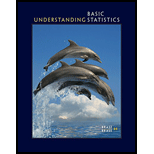
Concept explainers
Please provide the following information for Problems 11-22. part (a):
(i) What is the level of significance? State the null and alternate hypotheses.
(ii)Check Requirements What sampling distribution will you use? What assumptions are you making? What is the value of the sample test statistic? Compute the corresponding z or t value as appropriate.
(iii)Find (or estimate) the P-value. Sketch the sampling distribution and show the area corresponding to the P-value.
(iv)Based on your answers in parts (i)—(iii), will you reject or fail to reject the null hypothesis? Are the data statistically significant at level a?
(v)Interpret your conclusion in the context of the application.
Note: For degrees of freedom d.f. not in the Student's t table, use the closest d.f. that is smaller. In some situations, this choice of d.f. may increase the P-value a small amount, and therefore produce a slightly more “conservative” answer. Answers may vary due to rounding.
Agriculture: Bell Peppers The pathogen Phytophthora capsici causes bell peppers to wilt and die. Because bell peppers are an important commercial crop, this organism has undergone a great deal of agricultural research. It is thought that too much water aids the spread of the pathogen. Two fields are under study. The first step in the research project is to compare the
Field A samples, x1:
| 10.2 | 10.7 | 15.5 | 10.4 | 9.9 | 10.0 | 16.6 |
| 15.1 | 15.2 | 13.8 | 14.1 | 11.4 | 11.5 | 11.0 |
Field B samples, x2:
| 8.1 | 8.5 | 8.4 | 7.3 | 8.0 | 7.1 | 13.9 | 12.2 |
| 13.4 | 11.3 | 12.6 | 12.6 | 12.7 | 12.4 | 11.3 | 12.5 |
Use a calculator with mean and standard deviation keys to verify that
ˉx1≈12.53,s1≈2.39,ˉx2≈10.77, and s2≈2.40
(a) Assuming the distribution of soil water content in each field is mound-shaped and symmetrical, use a 5% level of significance to test the claim that field A has, on average, a higher soil water content than field B.
(b) Find a 90% confidence interval for µ1− µ2. Explain the meaning of the confidence interval in the context of the problem.
Want to see the full answer?
Check out a sample textbook solution
Chapter 10 Solutions
Understanding Basic Statistics
- Examine the Variables: Carefully review and note the names of all variables in the dataset. Examples of these variables include: Mileage (mpg) Number of Cylinders (cyl) Displacement (disp) Horsepower (hp) Research: Google to understand these variables. Statistical Analysis: Select mpg variable, and perform the following statistical tests. Once you are done with these tests using mpg variable, repeat the same with hp Mean Median First Quartile (Q1) Second Quartile (Q2) Third Quartile (Q3) Fourth Quartile (Q4) 10th Percentile 70th Percentile Skewness Kurtosis Document Your Results: In RStudio: Before running each statistical test, provide a heading in the format shown at the bottom. “# Mean of mileage – Your name’s command” In Microsoft Word: Once you've completed all tests, take a screenshot of your results in RStudio and paste it into a Microsoft Word document. Make sure that snapshots are very clear. You will need multiple snapshots. Also transfer these results to the…arrow_forward2 (VaR and ES) Suppose X1 are independent. Prove that ~ Unif[-0.5, 0.5] and X2 VaRa (X1X2) < VaRa(X1) + VaRa (X2). ~ Unif[-0.5, 0.5]arrow_forward8 (Correlation and Diversification) Assume we have two stocks, A and B, show that a particular combination of the two stocks produce a risk-free portfolio when the correlation between the return of A and B is -1.arrow_forward
- 9 (Portfolio allocation) Suppose R₁ and R2 are returns of 2 assets and with expected return and variance respectively r₁ and 72 and variance-covariance σ2, 0%½ and σ12. Find −∞ ≤ w ≤ ∞ such that the portfolio wR₁ + (1 - w) R₂ has the smallest risk.arrow_forward7 (Multivariate random variable) Suppose X, €1, €2, €3 are IID N(0, 1) and Y2 Y₁ = 0.2 0.8X + €1, Y₂ = 0.3 +0.7X+ €2, Y3 = 0.2 + 0.9X + €3. = (In models like this, X is called the common factors of Y₁, Y₂, Y3.) Y = (Y1, Y2, Y3). (a) Find E(Y) and cov(Y). (b) What can you observe from cov(Y). Writearrow_forward1 (VaR and ES) Suppose X ~ f(x) with 1+x, if 0> x > −1 f(x) = 1−x if 1 x > 0 Find VaRo.05 (X) and ES0.05 (X).arrow_forward
- Joy is making Christmas gifts. She has 6 1/12 feet of yarn and will need 4 1/4 to complete our project. How much yarn will she have left over compute this solution in two different ways arrow_forwardSolve for X. Explain each step. 2^2x • 2^-4=8arrow_forwardOne hundred people were surveyed, and one question pertained to their educational background. The results of this question and their genders are given in the following table. Female (F) Male (F′) Total College degree (D) 30 20 50 No college degree (D′) 30 20 50 Total 60 40 100 If a person is selected at random from those surveyed, find the probability of each of the following events.1. The person is female or has a college degree. Answer: equation editor Equation Editor 2. The person is male or does not have a college degree. Answer: equation editor Equation Editor 3. The person is female or does not have a college degree.arrow_forward
 Glencoe Algebra 1, Student Edition, 9780079039897...AlgebraISBN:9780079039897Author:CarterPublisher:McGraw Hill
Glencoe Algebra 1, Student Edition, 9780079039897...AlgebraISBN:9780079039897Author:CarterPublisher:McGraw Hill College Algebra (MindTap Course List)AlgebraISBN:9781305652231Author:R. David Gustafson, Jeff HughesPublisher:Cengage Learning
College Algebra (MindTap Course List)AlgebraISBN:9781305652231Author:R. David Gustafson, Jeff HughesPublisher:Cengage Learning

